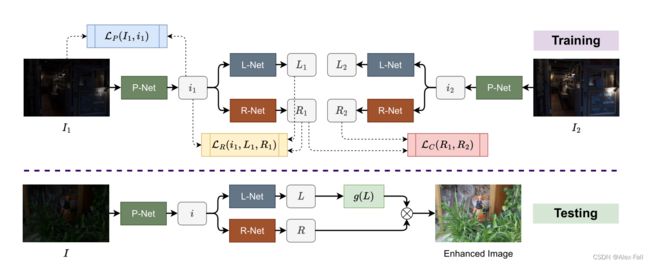PairLIE论文阅读笔记
PairLIE论文阅读笔记
论文为2023CVPR的Learning a Simple Low-light Image Enhancer from Paired Low-light Instances.论文链接如下:
openaccess.thecvf.com/content/CVPR2023/papers/Fu_Learning_a_Simple_Low-Light_Image_Enhancer_From_Paired_Low-Light_Instances_CVPR_2023_paper.pdf
文章目录
- PairLIE论文阅读笔记
-
- 出发点
- 创新点
- 模型
- 设计及其损失
出发点
1.However, collecting high-quality reference maps in real-world scenarios is time-consuming and expensive.
出发点1:在低光照领域,从现实世界中获取高质量的参考照片进行监督学习,既费时又困难,成本昂贵。
因为获得低光环境的照片是容易的,而此低光照片对应的亮度较大的参考图片是难得的。
2.To tackle the issues of limited information in a single low-light image and the poor adaptability of handcrafted priors, we propose to leverage paired low-light instances to train the LIE network.
Additionally, twice-exposure images provide useful information for solving the LIE task. As a result, our solution can reduce the demand for handcrafted priors and improve the adaptability of the network.
出发点2:为了解决手动设置的先验的低适应性,减少手动设置先验的需求,同时提升模型对陌生环境的适应性。
创新点
The core insight of our approach is to sufficiently exploit priors from paired low-light images.
Those low-light image pairs share the same scene content but different illumination. Mathematically, Retinex decomposition with low-light image pairs can be expressed as:
创新点1:作者利用两张低光图片进行训练,以充分提取低光图片的信息。
instead of directly imposing the Retinex decomposition on original low-light images, we adopt a simple self-supervised mechanism to remove inappropriate features and implement the Retinex decomposition on the optimized image.
创新点2:作者基于Retinex理论,但是并不循旧地直接运用Retinex的分解。作者采用一个简单的自监督机制以实现不合理特征的去除(通常是一些噪音)以及更好地实现Retinex理论。
模型
将两张同一场景不同曝光的低光图片送入训练中,图片I1与I2先经过P-Net去除噪音,得到i1与i2,然后利用L-Net与R-Net分解为照度L1与反射R1(对应有L2与R2)。
在测试,只需要输入一张低光照图片I,经过P-Net的噪音去除,得到i,然后用L-Net与R-Net分解为照度和反射,然后对照度L进行增强,操作为g(L),把增强结果与反射R进行元素乘法,得到增强后的图片Enhanced Image。
设计及其损失
Note that, this paper does not focus on designing modernistic network structures. L-Net and R-Net are very similar and simple,
1.模型使用的L-Net与R-Net十分简单。整体架构只是单纯的卷积神经网络。
Apart from L-Net and R-Net, we introduce P-Net to remove inappropriate features from the original image. Specifically, the structure of the P-Net is identical to the R-Net.
2,P-Net被设计用于去除不合理特征。
L p = ∣ ∣ I 1 − i 1 ∣ ∣ 2 2 L_p = \mid\mid I_1 - i_1 \mid\mid^2_2 Lp=∣∣I1−i1∣∣22
Note that the projection loss needs to cooperate with the other constraints to avoid a trivial solution.i,e.,i1 = I1.
3.Projection Loss:最大程度限制去除不合理特征后的i1和原始低光图片I1的区别。
这个损失需要避免一个特例,即降噪后图片与原图相同,即未降噪。
L c = ∣ ∣ R 1 − R 2 ∣ ∣ 2 2 (1) L_c = \mid\mid R_1 - R_2 \mid\mid^2_2\tag{1} Lc=∣∣R1−R2∣∣22(1)
Since sensor noise hidden in dark regions will be amplified when the contrast is improved.
In our method, the sensor noise can be implicitly removed by Eq. 1.
4.Reflection Loss:通常用传感或摄影设备拍摄低光场景照片会携带一定的设备噪音,这个损失最大限度保证两张图片的反射是相同的,减少传感或摄影设备的影响,这是因为图片场景的内容相同。
这个损失是确保反射的一致性。
L R = ∣ ∣ R ∘ L − i ∣ ∣ 2 2 + ∣ ∣ R − i / s t o p g r a d ( L ) ∣ ∣ 2 2 + ∣ ∣ L − L 0 ∣ ∣ 2 2 + ∣ ∣ ∇ L ∣ ∣ 1 L_R = \mid\mid R \circ L - i \mid\mid^2_2 + \mid\mid R - i / stopgrad(L)\mid\mid^2_2 + \mid\mid L - L_0 \mid\mid^2_2 + \mid\mid \nabla L \mid\mid_1 LR=∣∣R∘L−i∣∣22+∣∣R−i/stopgrad(L)∣∣22+∣∣L−L0∣∣22+∣∣∇L∣∣1
∣ ∣ R ∘ L − i ∣ ∣ 2 2 \mid\mid R \circ L - i \mid\mid^2_2 ∣∣R∘L−i∣∣22 is applied to ensure a reasonable decomposition.
∣ ∣ R − i / s t o p g r a d ( L ) ∣ ∣ 2 2 \mid\mid R - i / stopgrad(L) \mid\mid^2_2 ∣∣R−i/stopgrad(L)∣∣22 is to guide the decomposition.
Specifically, the initialized illumination L0 is calculated via the maximum of the R, G, and B channels: L 0 = m a x c ∈ R , G , B I c ( x ) . L_0 = \underset{c \in{R, G, B}}{max} I^c(x). L0=c∈R,G,BmaxIc(x).
5.Retinex Loss:Retinex损失是为了限制分解组块L-Net和R-Net以满足Retinex的理论要求。
本文毕

